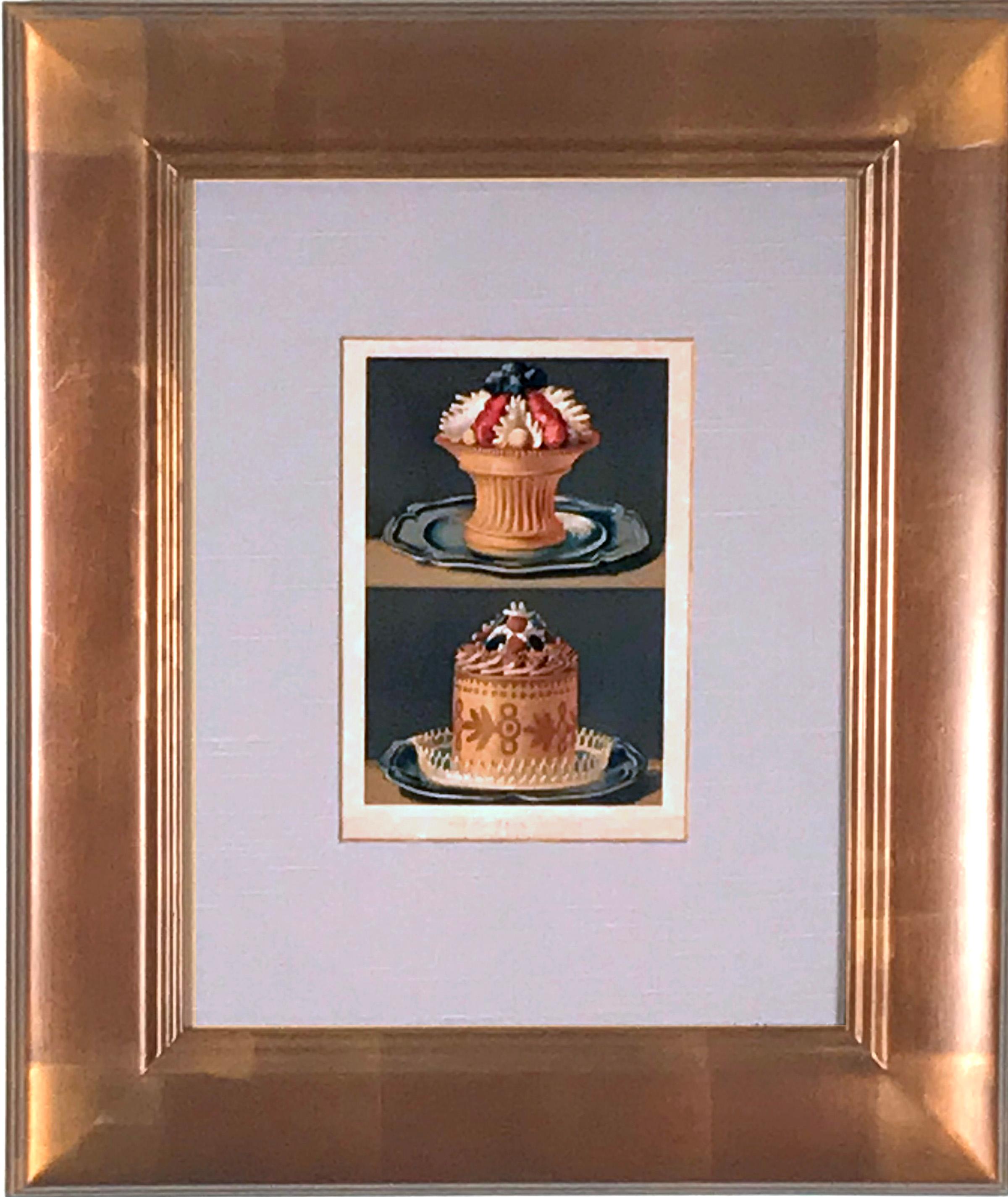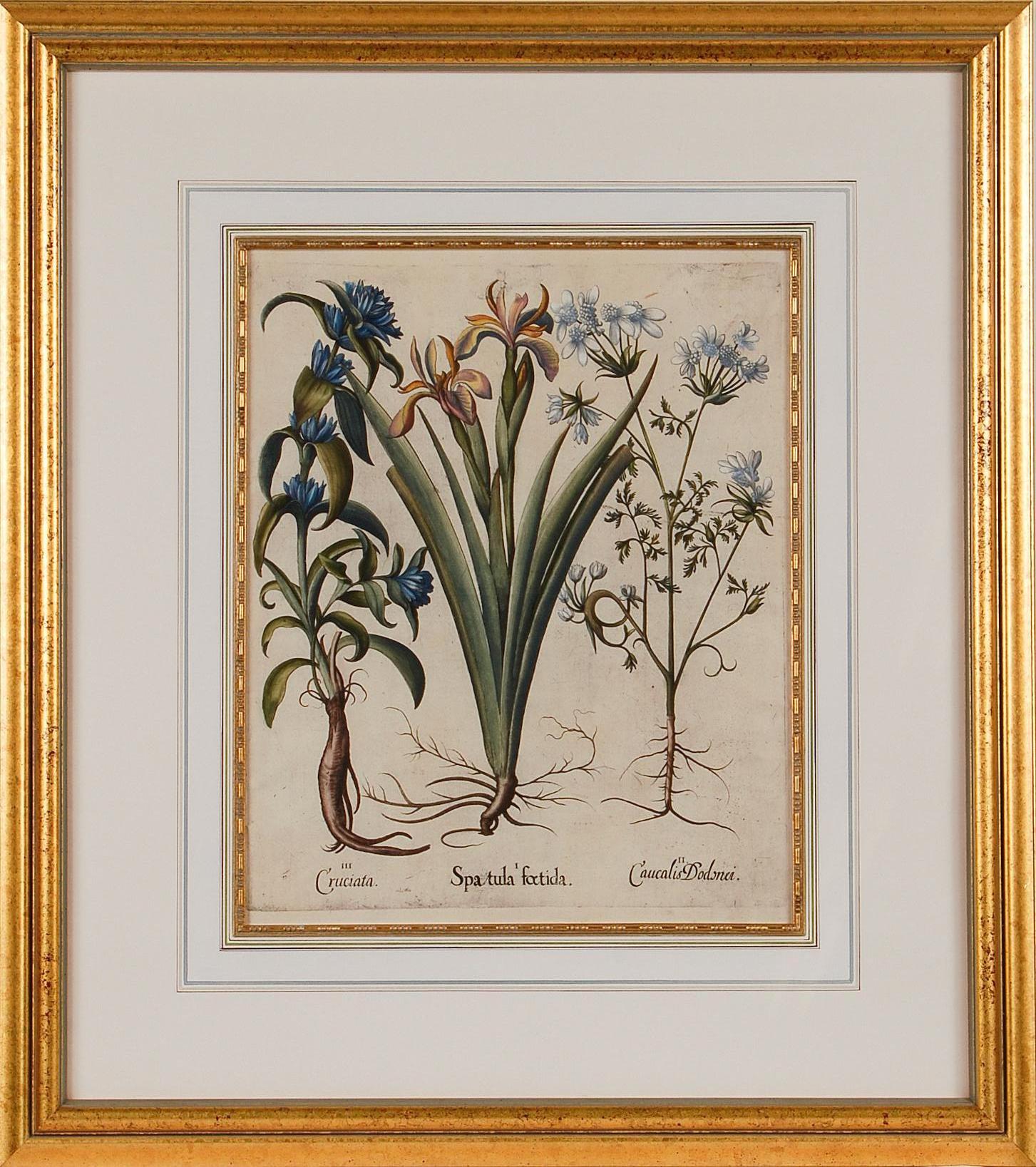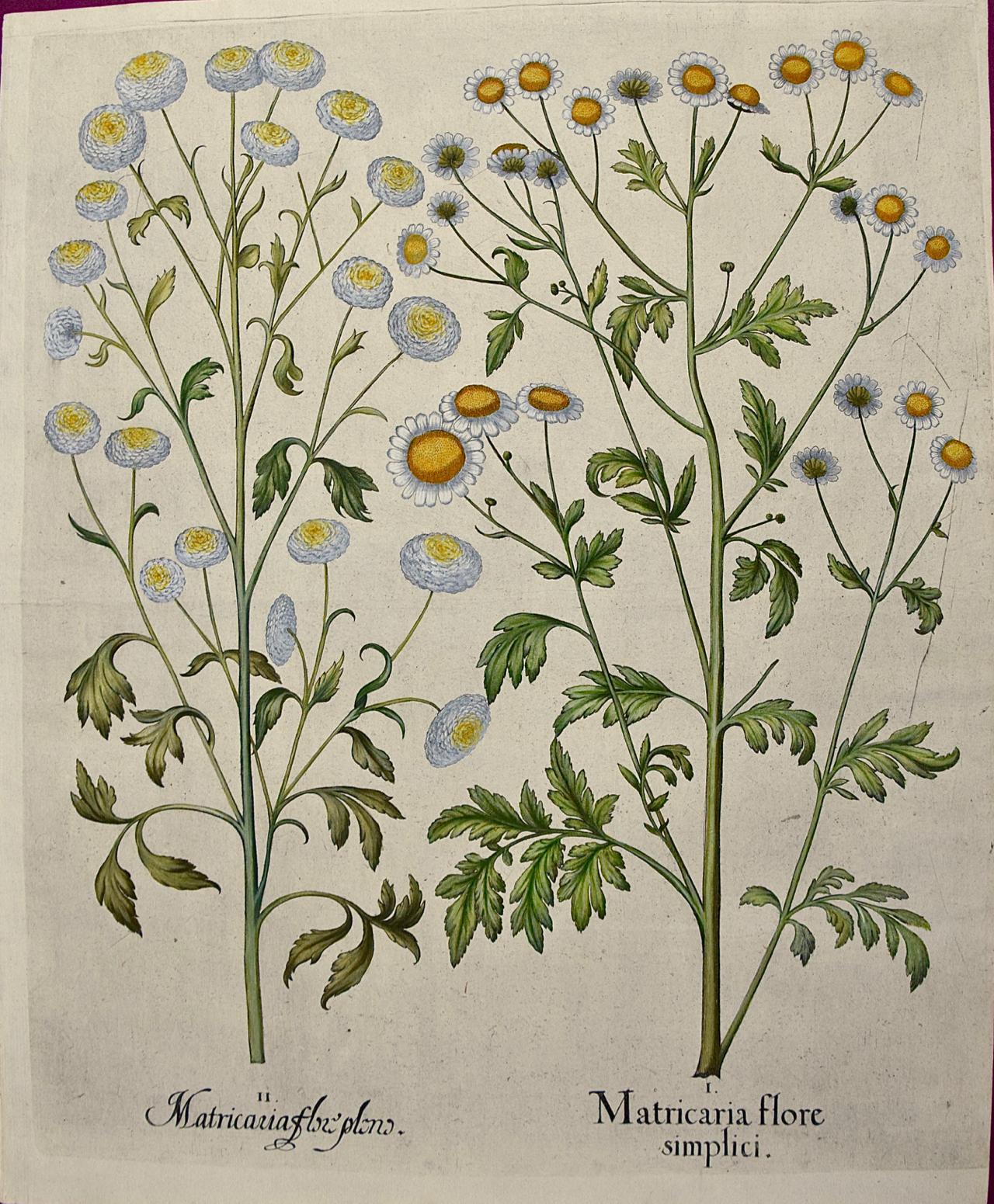Items Similar to "Fruit & Flowers, " Original Hand-colored Lithograph signed by Nathaniel Currier
Want more images or videos?
Request additional images or videos from the seller
1 of 9
Nathaniel Currier"Fruit & Flowers, " Original Hand-colored Lithograph signed by Nathaniel Currier1848
1848
About the Item
"Fruit & Flowers" is an original hand-colored lithograph by Nathaniel Currier. It features a still life with grapes, roses, and other botanical objects. The colors are muted blues and yellows. The artist signed the piece in plate lower left.
11 3/4" x 8 1/2" art
22 1/8" x 18" frame
Nathaniel Currier was born March 27, 1813 to Nathaniel and Hannah Currier in Roxbury, Massachusetts. At the age of fifteen he was apprenticed to William S. and John Pendleton of Boston who had set up the first lithographic establishment in America. His apprenticeship served him well as he went on to be the largest publisher of lithographs. Mr. Maurer described Nat Currier as being very gentlemanly and liberal. As is evident to the success of the firm of Currier & Ives he was very devoted to his business.
Nat Currier had many friends including Horace Greely and P.T. Barnum. He was well known for his sense of humor and Harry T. Peters tells one story about P. T. Barnum. "Currier had heard that one day his friend, the great showman, had rushed into the barber shop of the old Park Hotel, at Beekman and Nassau Streets, to get a shave. Barnum had hurried up to Tom Higginson, the barber, and said, 'Tom, I'm in a hurry.' 'Sorry for it,' said Tom, 'but it's that gentleman's turn next.' 'That gentleman' was an unshaven irshman waiting for a ten-cent shave. Barnum turned to him and said, 'My friend, if you will let me have your turn, I'll pay for what you have done.' The gentleman consented, and, as Barnum found out later, had a full job done - absolutely everything the house had. The check was for a dollar and sixty cents. When Currier heard this story he found the very Irishman and had him pose. The result was the famous cartoon, "The Man that Gave Barnum 'His Turn.'"
Nathaniel was married twice; his first wife was Miss Eliza West of Boston. He had one son with Eliza, Edward West Currier. In 1847 he married Miss Laura Ormsbee of Vermont. Laura and Nathaniel are memorialized in the famous N. Currier lithograph The Road Winter. He lived at several addresses in New York City including 153 Macdougal Street, 137 Macdougal Street and 28 West 27th Street. He had a summer house called "The Lion's Mouth" in Amesbury, Massachusetts. He was known to like fast horses and he kept several in Amesbury. Nathaniel died on November 20, 1888 at his home on 28 west 27th Street.
- Creator:Nathaniel Currier (1813 - 1888, American)
- Creation Year:1848
- Dimensions:Height: 22.125 in (56.2 cm)Width: 18 in (45.72 cm)
- Medium:
- Movement & Style:
- Period:
- Condition:
- Gallery Location:Milwaukee, WI
- Reference Number:
About the Seller
4.9
Platinum Seller
These expertly vetted sellers are 1stDibs' most experienced sellers and are rated highest by our customers.
Established in 1966
1stDibs seller since 2017
391 sales on 1stDibs
Typical response time: 1 hour
- ShippingRetrieving quote...Ships From: Milwaukee, WI
- Return PolicyA return for this item may be initiated within 14 days of delivery.
More From This SellerView All
- "Boldest Native" original lithograph signed pop art abstract hyperrealistic boldBy Michael KniginLocated in Milwaukee, WI"Boldest Native" is an original color lithograph by Michael Knigin. This piece features a pile of apples with abstract textures. The artist signed the piece lower right and titled it...Category
1980s Pop Art Still-life Prints
MaterialsLithograph
- "Back Cover of "Chagall Lithographe III, " M 577, " an Original Color LithographBy Marc ChagallLocated in Milwaukee, WIThis is the back cover of "Chagall Lithographe III," M 577". It is an original Lithograph by Marc Chagall. This print is a glorious black and red bouquet, most of the foliage is shown by black leaves and stems where as the flowers and blooms are red. Also on the top right one can see a tiny red bird. Image: 12.5 x 10 in Frame: 25.5 x 21.5 in Marc Chagall was born in Liozno, near Vitebsk, now in Belarus. The eldest of nine children in a close-knit Jewish family. His father Khatskl (Zakhar) Shagal, a herring merchant, and his mother, Feige-Ite. This period of his life, described as happy though impoverished, appears in references throughout Chagall's work. The family home on Pokrovskaya Street is now the Marc Chagall Museum. He began studying painting in 1906 with a local artist, Yehuda Pen. In 1907, he moved to St. Petersburg. There he joined the school of the Society of Art Supporters and studied under Nikolai Roerich. It was here that he was exposed to experimental theater and the work of such artists as Gauguin. From 1908-1910 Chagall studied under Leon Bakst at the Zvantseva School of Drawing and Painting. This was a difficult period for Chagall; at the time, Jewish residents were only allowed to live in St. Petersburg with a permit, and the artist was jailed for a brief period for an infringement of this restriction. Despite this, Chagall remained in St. Petersburg until 1910, and regularly visited his home town where, in 1909, he met his future wife, Bella Rosenfeld. After gaining a reputation as an artist, Chagall left St. Petersburg to settle in Paris to be near the burgeoning art community in the Montparnasse district, where he developed friendships with such avant-garde luminaries as Guillaume Apollinaire, Robert Delaunay, and Fernand Léger. In 1914, he returned to Vitebsk and, a year later, married his fiancée, Bella. While in Russia, World War I erupted and, in 1916, the Chagalls had their first child, a daughter named Ida. Chagall became an active participant in the Russian Revolution of 1917. Although the Soviet Ministry of Culture made him a Commissar of Art for the Vitebsk region, where he founded Vitebsk Museum of Modern Art and an art school, he did not fare well politically under the Soviet system. "Chagall was considered a non-person by the Soviets because he was Jewish and a painter whose work did not celebrate the heroics of the Soviet people."[6] He and his wife moved back to Paris in 1922. During this period, Chagall wrote articles, poetry and his memoirs (in Yiddish,) which were published mainly in newspapers (and only posthumously in book-form). Chagall became a French citizen in 1937. With the Nazi occupation of France during World War II and the deportation of Jews, the Chagalls fled Paris, seeking asylum at Villa Air-Bel in Marseille, where the American journalist Varian Fry assisted in their escape from France through Spain and Portugal. In 1941, the Chagalls settled in the United States where he lived until 1948 (his wife Bella died in 1944.) His wife Bella, who appears in many of his paintings, bore him one child, Ida and then died on September 2, 1944. Bella and Ida appeared in many of his early and most famous paintings. In 1945, he began a relationship with his housekeeper Virginia Haggard McNeil, with whom he had a son, David. In the 1950s, they moved to a villa in Provence. Virginia left him in 1952, and Chagall married Valentina Brodsky (whom he called "Vava"). Jewish influence: Chagall had a complex relationship with Judaism. On the one hand, he credited his Russian Jewish cultural background as being crucial to his artistic imagination. But however ambivalent he was about his religion, he could not avoid drawing upon his Jewish past for artistic material. As an adult, he was not a practicing Jew, but through his paintings and stained glass, he continually tried to suggest a more "universal message," using both Jewish and Christian themes...Category
1960s Surrealist Still-life Prints
MaterialsLithograph
- "La Peine Perdue (The Wasted Effort)" Lithograph after Painting by Rene MagritteBy René MagritteLocated in Milwaukee, WI"La Peine Perdue (The Wasted Effort)" is a color lithograph after original 1962 painting by Rene Magritte. Two blue curtains are parted on either side. Two curtain shaped mirrors show a sky and clouds. A ball sits right to the left of the mirrors. Art: 12 x 9.75 in Frame: 22.75 x 20.38 in René-François-Ghislain Magritte was born November 21, 1898, in Lessines, Belgium and died on August 15, 1967 in Brussels. He is one of the most important surrealist artists. Through his art, Magritte creates humor and mystery with juxtapositions and shocking irregularities. Some of his hallmark motifs include the bourgeois “little man,” bowler hats, apples, hidden faces, and contradictory texts. René Magritte’s father was a tailor and his mother was a miller. Tragedy struck Magritte’s life when his mother committed suicide when he was only fourteen. Magritte and his two brothers were thereafter raised by their grandmother. Magritte studied at the Brussels Academy of Fine Arts from 1916 to 1918. After graduating he worked as a wallpaper designer and in advertisement. It was during this period that he married Georgette Berger, whom he had known since they were teenagers. In 1926, René Magritte signed...Category
2010s Surrealist Still-life Prints
MaterialsLithograph
- "Campions, " Lithograph Still Life by Sheila StaffordBy Sheila StaffordLocated in Milwaukee, WI"Campions" is an original color lithograph by Sheila Stafford. The artist signed the piece in the lower right and titled it and wrote the edition number (24/24) in the lower left - b...Category
1980s Still-life Prints
MaterialsLithograph
- "Two Bottles & Bowl, " Original Black & White Litho. signed by Joan Gardy ArtigasBy Joan Gardy ArtigasLocated in Milwaukee, WI"Two Bottles & Bowl" is an original lithograph by Joan Gardy Artigas. It depicts a still life in black and white. The artist signed the piece lower right and wrote the edition number...Category
Mid-20th Century Abstract Expressionist Still-life Prints
MaterialsLithograph
- "Bodegon - Still Life: Apple, Pear, & Funnel in Box, " Original Color LithographBy Armando MoralesLocated in Milwaukee, WI"Bodegon - Still Life: Apple, Pear & Funnel in Box" is an original color lithograph by Armando Morales. The artist signed the piece and this piece is the presentation proof for the e...Category
1980s Contemporary Still-life Prints
MaterialsLithograph
You May Also Like
- Supreme de Volaille -- Cotelettes d' AgneauBy Jules GouffeLocated in Florham Park, NJJules Gouffe (1807-1877) Le Livre de Cusine Librairie Hachette et Cie Paris, 1867 Chromolithographs At the age of 16, Jules Gouffe found his calling as a student of the famous...Category
Mid-19th Century Academic Still-life Prints
MaterialsLithograph
- Pate Choud a la Financier, Timbale MillinaiseBy Jules GouffeLocated in Florham Park, NJJules Gouffe (1807-1877) Le Livre de Cusine Librairie Hachette et Cie Paris, 1867 Chromolithographs At the age of 16, Jules Gouffe found his calling as a student of the famous Lent....Category
Mid-19th Century Academic Still-life Prints
MaterialsLithograph
- Flowering Iris & Other Botanicals: Framed 17th C. Besler Hand-colored EngravingLocated in Alamo, CAThis is a hand-colored copper-plate engraving entitled "I. Spatula foetida - II. Caucalis Dodonei - III. Cruciata", depicting three flowering plants, including an Iris, from Basilius Besler's landmark work, Hortus Eystettensis (Garden at Eichstatt), first published in 1613 in Eichstatt, Germany near Nuremberg and later in 1640 and 1713. This beautiful hand-colored botanical engraving is presented in a gold-colored wood frame with a French mat...Category
Mid-17th Century Academic Still-life Prints
MaterialsEngraving
- Flowering Feverfew Plants: A 17th C. Besler Hand-colored Botanical EngravingLocated in Alamo, CAThis is a hand-colored copper plate engraving entitled "Matricaria Flore Simplici, Matricaria Flore Pleno, depicting flowering Feverfew and Double-flowered Feverfew plants, from Basilius Besler's landmark work, Hortus Eystettensis (Garden at Eichstatt), first published in 1613 in Eichstatt, Germany near Nuremberg and later in 1640 and 1713. The feverfew plant is also known as featherfew, featherfoil, or bachelor’s buttons...Category
1640s Academic Still-life Prints
MaterialsEngraving
- Flowering Lily Plants: A 17th C. Besler Hand-colored Botanical EngravingLocated in Alamo, CAThis is a hand-colored copper plate engraving entitled "Cataputia Vulgaris, Parietaria Sylvestris, Nummularia", depicting flowering Spanish Nut, Yellow Turk's-cap Lily, Yellow Turk's...Category
1640s Academic Still-life Prints
MaterialsEngraving
- Flowering Pomegranate & Rock Rose: A 17th C. Besler Hand-colored EngravingLocated in Alamo, CAThis is a hand-colored copper-plate engraving entitled "Cistusflore Albo, Balaustium Flore Minori Romanum, Cotinus", depicting flowering Pomegranate, Rock Rose...Category
1640s Academic Still-life Prints
MaterialsEngraving
Recently Viewed
View AllMore Ways To Browse
Antique Shop Sign Signs
Antique Business Sign
Antique Business Signs
1840 Flowers
Hand Colored Botanicals
Hand Colored Botanical
Antique Colored Roses
Antique Hotel Sign
Antique Hotel Signs
Antique Vermont
Vermont Antique
Framed Horse Lithograph
Hand Colored Botanical Prints
Botanical Sets Flowers
Antique Dollar
Antique Dollars
Antique Horse Lithograph
Antique Fruit Prints





